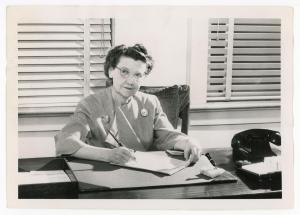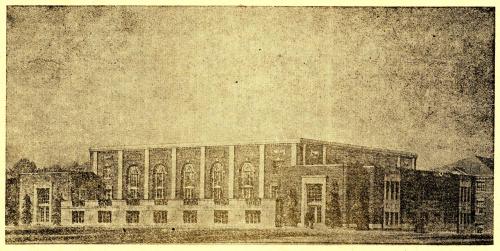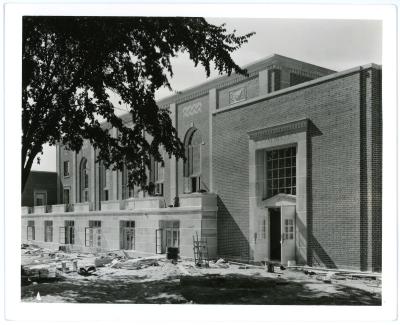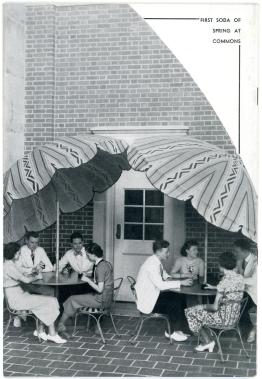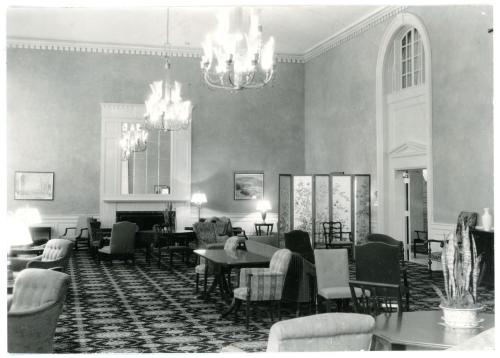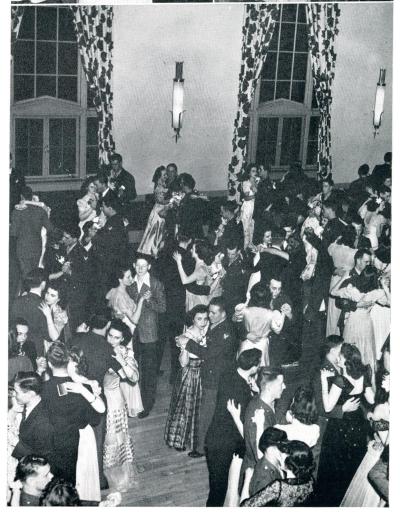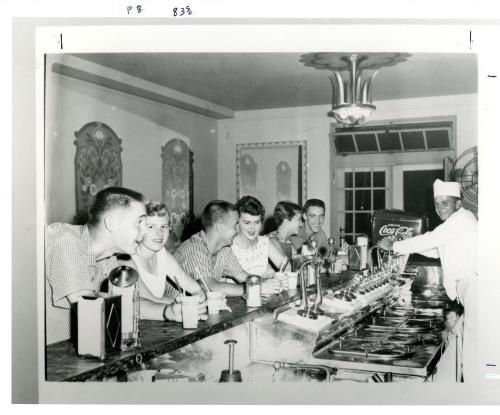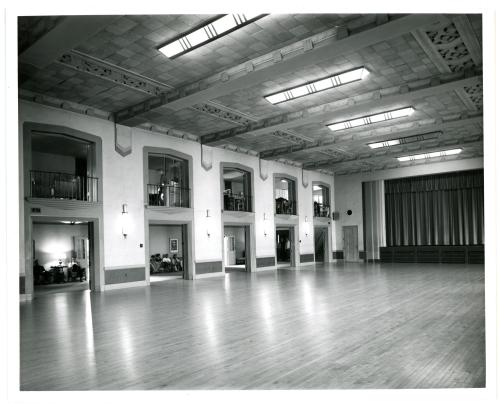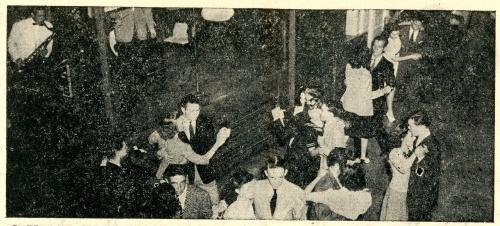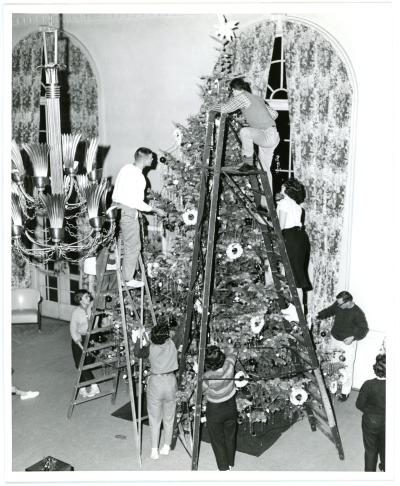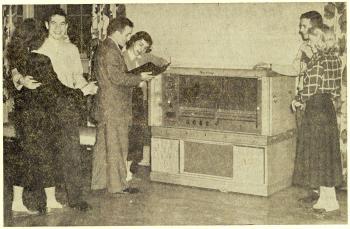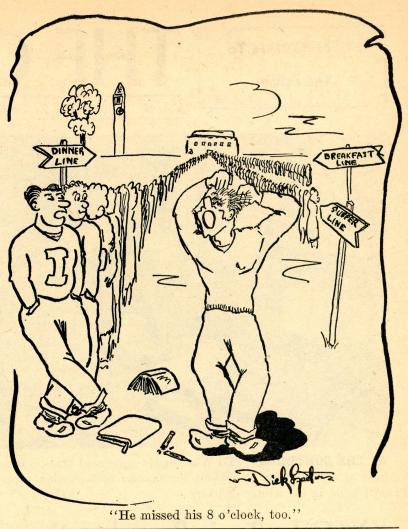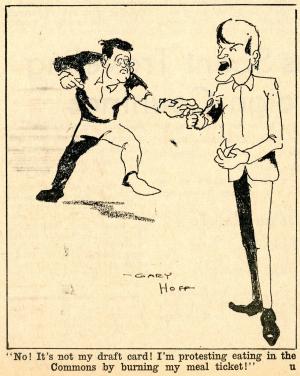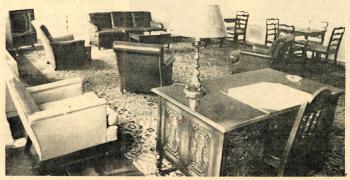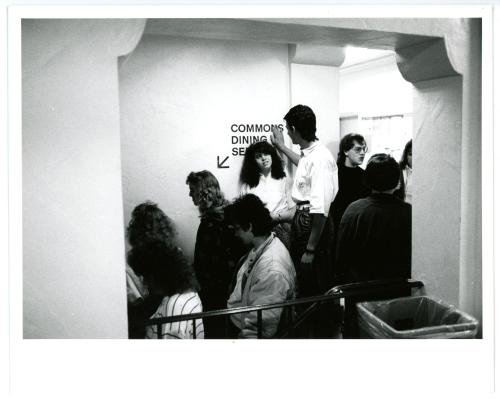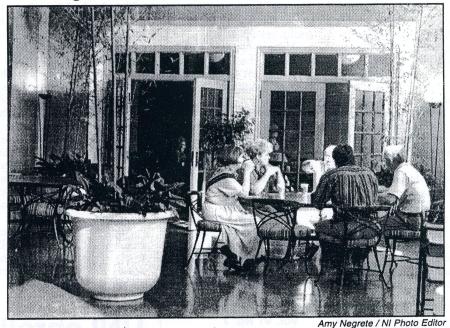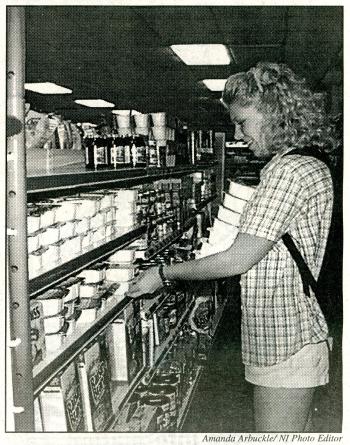
College officials had their first tentative discussions about a campus recreation center in the early 1920s. At least some of the consideration had to do with keeping students on campus for such activities as social dancing, rather than allowing them to hold parties off campus where they would be less subject to college supervision. However, a shortage of funds and an inadequate heating plant caused the Board of Education to defer action. In the fall of 1931 President O. R. Latham recommended a substantial expansion of Bartlett Hall, but the Board of Education turned down that proposal. During the Christmas vacation of 1931-1932, officials including President Latham, Dean of Women Sadie Campbell, and Dean of Men Leslie Reed formulated preliminary floor sketches and educational specifications for a campus recreation and dining center, which they submitted to the Board early in 1932.
The Board approved the preliminary ideas, and, in February 1932, President Latham announced plans for a College Commons to provide recreational facilities for all students and dining service for the women who lived in Bartlett Hall, at that time the only dormitory on campus. The new Commons would be attached to the west wing of Bartlett Hall. President Latham said, "The Commons here will be to this campus what the memorial unions are to most colleges and universities." The exact origin of applying the name Commons to the proposed facility on this campus is unclear at this point. But, in a collegiate context, commons usually refers to some sort of shared dining area. Dean of Women Sadie B. Campbell described the project as an intentional endeavor in "social education". She saw the Commons as a setting in which students could broaden their education to include learning to live with other people. Dean Campbell's influence on the development of the Commons and its programs cannot be underestimated.
Architects Proudfoot, Rawson, Souers, and Thomas, of Des Moines, drew up preliminary sketches. The projected cost was between $100,000 and $200,000. Funding would be provided from money accumulated over the years from the operation of Bartlett Hall. The building would include two large dining rooms, a kitchen, offices, a post office, a telephone switchboard, and an information booth on the first level. On the second level, there would be a ballroom, a lounge and promenade, check rooms, restrooms, and smaller lounge areas. The south side of the building would feature an open terrace connected to a fountain room. The dimensions of the Commons would be 160 feet by 115 feet.
The Board of Education approved the architectural plans in April 1932. President Latham hoped that construction could get under way by July 1, 1932, and that the building would be completed in time for the spring 1933 Commencement. In July 1932, the student newspaper, the College Eye, made its first editorial comment on the new building when it asked that smoking be permitted there. The editorial stated that at least for most college men, smoking was a normal part of life.
The Board of Education opened bids on July 27, 1932, and gave a general contract of $118,284 to Anderson Construction Company of Council Bluffs. The Board gave a plumbing contract of $19,545 to Carstens Brothers Company of Ackley, and an electrical contract of $3997 to Cedar Rapids Electrical Supply Company. President Latham had anticipated much higher bids and was pleased when they came in so low. The contract called for completion of the work by May 10, 1933.
On August 10, 1932, construction began on the building. By mid-October the excavation and basement masonry were done and work on the brick walls began. The project would use about ninety thousand bricks that matched those used in Bartlett Hall. Inclement winter weather slowed the project and actually stopped work for awhile in mid-February 1933. The projected completion date was pushed back to July. By late June, the plaster work had been completed. But flooring, doors, some woodwork, plumbing fixtures, lighting equipment, kitchen fixtures, ceiling tile, and a freight elevator still needed to be installed. Officials hoped that the building would be ready for use by the opening of the fall 1933 term.
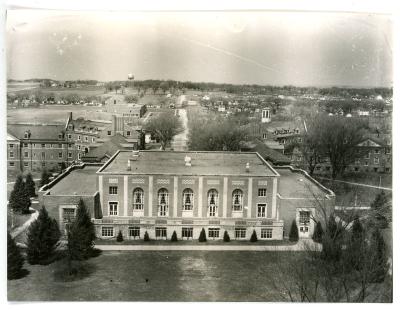 A writer in an August 1933 issue of the College Eye rhapsodized about the decorating scheme to be used in the new facility. Walls would be ivory, with "an antique effect, modernistic silver scroll effects overhead, and doors and woodwork of graduated colors from blue to old rose to deep mahogany red are the characteristics . . . green damask draperies simply hung against the ivory of the woodwork . . . wall hangings, floor screens, and Georgian mirrors over the two fireplaces . . . ." A key word here is "modernistic". Despite many of its "Georgian" trappings, the building would display many remarkable examples of the Art Deco style.
A writer in an August 1933 issue of the College Eye rhapsodized about the decorating scheme to be used in the new facility. Walls would be ivory, with "an antique effect, modernistic silver scroll effects overhead, and doors and woodwork of graduated colors from blue to old rose to deep mahogany red are the characteristics . . . green damask draperies simply hung against the ivory of the woodwork . . . wall hangings, floor screens, and Georgian mirrors over the two fireplaces . . . ." A key word here is "modernistic". Despite many of its "Georgian" trappings, the building would display many remarkable examples of the Art Deco style.
The Commons opened for student use on September 10, 1933. The cafeteria opened the next day. The total cost of the project was about $215,000. A College Eye editorial writer praised the college administration for its work in planning, developing, and building the new facility. The writer then put the responsibility for its use and success in the hands of the students.
The Commons quickly became the center of many activities, including the Homecoming program of 1933. Formerly, visitors had had to rely on chance campus encounters to meet old friends. But now the Commons offered a pleasant, centralized location for alumni to register and meet old classmates. An October campus visitor, Dean of Women Thyrsa W. Amos of the University of Pittsburgh, advised students to appreciate the building and its furnishings and to use the building as a setting for developing new friendships.
Students could take advantage of many recreational activities at the Commons: cards, phonographs to play records for dancing, books, and radios.
The Fountain Room, which featured a soda fountain and snacks, opened onto the south terrace.
A second floor series of balconies overlooked the recreation room, where dances were often held.
Students occasionally chaffed about Commons rules, especially those relating to the use and scheduling of certain rooms. Editorial writer Ruth Eddy, in a 1937 issue of the College Eye, wondered why more rooms could not be open for dancing and recreation in the afternoon, especially Friday afternoons. She asked, " . . . why have a place where surplus energy may be utilized shut up--and instead, try to keep all the energy shut up in the library?" This theme that contrasted the roles of the Commons and the Library would recur from time to time. Later in that same year, student Eugene Enderlein complained that the Commons was in heavy use during mealtimes, but was underutilized at other times. He also criticized the theoretical basis of the facility. "True, the Commons was to aid in social education. Its administration has, however, dwelt more on the theoretical improvement than that to be gained through actual experience." He went on to say that the Commons administration should spend less time on teaching manners, and more time on informal recreation. Within a couple of years the administration responded with recreational dancing hours on every day of the week except Sunday. And by 1940, the Commons was promoting itself as the better alternative to a trip back home for the weekend.
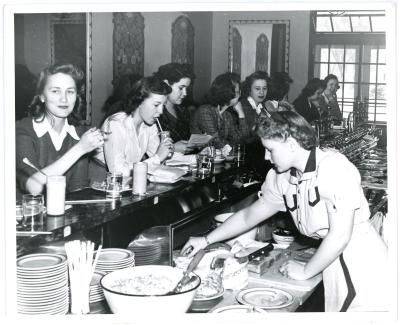
Despite a certain amount of grumbling, students did use the Commons, especially for social activities with dancing. By the summer of 1938, the dance floor already needed to be refinished. And certainly the cafeteria line, with its uniformed staff, was busy. In September 1938, the line was serving over five thousand meals a week, going through five quarters of beef, twenty-five gallons of mayonnaise, and lots of freshly baked cakes and pies.
In 1940, Commons Director Catherine Peck asked librarian Jessie Ferguson to supplement the Commons lending library of about two hundred books. Also that year two new radio-phonographs were installed "with a collection of popular, semi-classical, and classical records available for the use of any student who wishes to play them at almost any time in the day." And a game room opened with ping-pong tables, checkers, parchesi, backgammon, chess, bingo, dominos, cribbage, Monopoly, pick-up sticks, Chinese checkers, and cards. In an era when few students had cars and College Hill resembled a small town Main Street shopping district, the Commons served as the entertainment and recreation needs of many students.
Still, tensions continued over the perceived formality and expected standards of behavior in the building. In the fall of 1940, students met with new Commons Director Catherine Spooner, who had herself just graduated from the college in 1939. They asked that the dance floor and the fountain room be open Monday through Saturday from noon until 7PM. They wanted couples attending dances to be able to leave and return during the course of the dance. And they wanted smoking to be permitted in more areas of the building. As a College Eye writer phrased it, students wanted to see the Commons transformed into a "center of social life". This, of course, was a less than subtle counterpoint to the administrative view that the Commons should serve as a center of "social education".
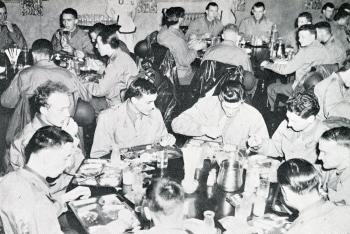
Whatever students thought of the atmosphere in the Commons, the dining and food service facilities received heavy use. The floor in the Fountain Room, a very popular spot in which to get a Coke or a milk shake, was worn out after just seven years. In the kitchen of the cafeteria, a dish washing machine and a corps of student workers washed three million pieces of tableware annually. In March 1942, an ice cream making machine was installed. It could make sixty gallons per batch. Ice cream sales soared during that warm spring.
In the summer of 1942, the recreation hall, the main lounge, and the mezzanine were redecorated and fitted with new drapes. The recreation hall featured chartreuse walls with borders of blue and turquoise. The new draperies were shades of blue. Romolo Roberti, an artist associated with the Art Institute in Chicago, directed the work.
The war years, with large contingents of WAVES and Army Air Corps trainees on campus, put a heavy strain on both the recreational facilities and the dining facilities of the Commons. In the winter of 1943, a new refrigeration unit was installed in the basement of the Commons to accommodate the large numbers of trainees who would need to be fed during the summer. The cafeteria, which served about one thousand meals a day before the war, served over five thousand meals a day during the war. A single meal might require seven hundred pounds of chicken, six hundred pounds of mashed potatoes, 140 dozen rolls, 220 pies, and 325 gallons of milk. One dairy truck did nothing other than deliver milk to the Commons all day. Vivain Barkhurst supervised a staff of seventy-nine full-time kitchen employees. The military trainees enjoyed the wide array of fresh fruit and vegetables. While food for the trainees came from federal government allotments, college dietitians had to watch their ration points in order to feed the students who were enrolled during the war. Serving Swiss steak, for example, used up meat ration points for three days. Most sources of protein, such as meat, eggs, cheese, and fish, were scarce.
Military personnel and students also enjoyed frequent dances and mixers in the Commons ballroom. Visiting servicemen or former students liked to look at the Commons guestbook, where they could catch up on where someone was stationed, what his rank was, or who was now married.
With the end of the military training programs on campus in 1944, some months before the end of the war, the college began to prepare for post-war changes. The east dining room was redecorated in red, green, and gardenia white. President Price entertained the faculty in the fresh, new surroundings.
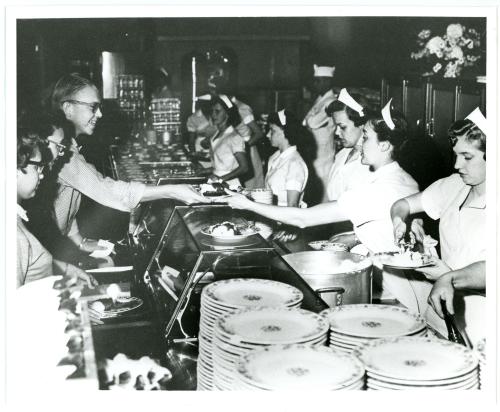 With the end of the war, and an influx of large numbers of students, there was grumbling about long food service lines and higher prices. The college tried "standardized" meal service in order to speed up the lines. This method served exactly the same food in the same portions to everyone. When students claimed that meals in restaurants were less expensive than Commons meals, the administration pointed to the higher quality of nutrition offered by the college. Students also protested a proposed rule that would require students living in the dormitories to have a meal contract. Postwar shortages added to the difficulties. Meat was difficult to obtain. An order of dinner plates, placed before the attack on Pearl Harbor in December 1941, had not yet arrived by September 1946. Still, a November 1946 student survey showed that most students believed that they were getting their money's worth at the Commons, that they were getting a sufficient quantity of food, and that it was cheaper than eating off-campus.
With the end of the war, and an influx of large numbers of students, there was grumbling about long food service lines and higher prices. The college tried "standardized" meal service in order to speed up the lines. This method served exactly the same food in the same portions to everyone. When students claimed that meals in restaurants were less expensive than Commons meals, the administration pointed to the higher quality of nutrition offered by the college. Students also protested a proposed rule that would require students living in the dormitories to have a meal contract. Postwar shortages added to the difficulties. Meat was difficult to obtain. An order of dinner plates, placed before the attack on Pearl Harbor in December 1941, had not yet arrived by September 1946. Still, a November 1946 student survey showed that most students believed that they were getting their money's worth at the Commons, that they were getting a sufficient quantity of food, and that it was cheaper than eating off-campus.
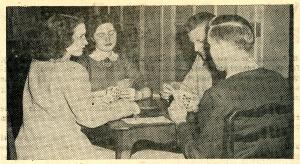
In any case, many students found the Commons a convenient place to spend the noon hour. Bridge was the most common activity, but many danced to records, and veterans found old friends and swapped war stories. The College Eye reported that from September through December 1947, the Commons hosted two picnics, six teas, fifteen dances, seven musicales, five student-faculty functions, and ten miscellaneous activities. For a college with an enrollment of a little over two thousand, that is an impressive list.
In 1949, artist George Rackelman, of Des Moines, painted a series of murals that were mounted behind the Commons serving line. The series depicted historical scenes from the campus. In 1951, a Seeburg 200 juke box was installed in the Commons ballroom. The machine held one hundred records. Students were invited to donate records to fill the machine. Keeping the machine supplied with donated records became a consistent problem over the following years. When a new machine was installed in 1955, the Commons still relied on student and organization donations to keep it stocked.
Certain older traditions began to fall away in the early 1950s. In 1952 women were allowed to smoke in the Commons for the first time, and, in a poll, seventy per cent of students favored Sunday dancing. Students also began to assert themselves a bit more by calling for a greater voice in determining Commons programming, which had been under the control of the Dean of Women. In the fall of 1953, a television set was installed in the Commons, just in time for the World Series. The year 1955 saw a major controversy over a ruling by Associated Women Students, the women's governance unit, that women were prohibited from wearing jeans in the Commons. Editorials and letters flew back and forth in the College Eye, until the group rescinded its ruling.
Early in 1956 a group of students began to raise money to purchase artwork for the Commons. Their original selection was a piece called "Transaction" by Charles Cajori, which was available for sale for $250. Over three hundred students and faculty contributed to the fund. On March 5, 1953, President Maucker accepted the work, which was later hung in the west corridor of the Commons. Even though a College Eye editorial writer suggested the alternative titles "Cajori's Careenings" or "Commons Calamity" for the piece, its purchase can be seen as the foundation for the campus fine art collection. As a result of this fundraising effort, a fund for the purchase of original artwork was established in the Business Office.
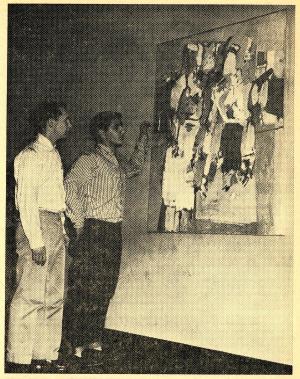 By the middle 1950s there was talk about a new or expanded Commons. A sarcastic College Eye writer suggested that it made better sense to expand the Library, since, in his opinion, students were using the Library for socializing rather than for study. He suggested converting the Library stacks into a combination snack bar and lounge. And the reading room could become a dance floor. On a more serious note, students complained long and loud about lengthy waiting lines for food, especially at noon. Commons and college officials knew that they had a significant problem, but, as Commons Food Service Director Margaret Fitzgerald said, "It's not that we can't buy more equipment for the preparation of food, but there isn't anywhere to put it."
By the middle 1950s there was talk about a new or expanded Commons. A sarcastic College Eye writer suggested that it made better sense to expand the Library, since, in his opinion, students were using the Library for socializing rather than for study. He suggested converting the Library stacks into a combination snack bar and lounge. And the reading room could become a dance floor. On a more serious note, students complained long and loud about lengthy waiting lines for food, especially at noon. Commons and college officials knew that they had a significant problem, but, as Commons Food Service Director Margaret Fitzgerald said, "It's not that we can't buy more equipment for the preparation of food, but there isn't anywhere to put it."
At about this time, the idea of a true student union began to arise. Students proposed that the Commons be converted to recreational services, and that dormitory dining services be placed in dormitories. They proposed that the transition of the Commons to a union be financed by a $5 per term student fee. By May 1959 a committee had been established to consider expansion of the Commons. Survey results showed that students were interested in an information desk, which would handle sales of tickets, newspapers, magazines, tobacco, candy, and postage; a checkroom; a book and supply store; a bowling alley; a music listening room; and a large snack bar. The Regents authorized a study of an expansion and hired consultant Porter Butts, of the University of Wisconsin, to look into the matter.
In 1960 the Commons began to offer a series of concerts and performances. The Brothers Four and Bob Newhart appeared in the first year. Progress continued on plans for remodeling or expanding the Commons when the Regents approved a $3 student fee increase, earmarked for that purpose, to begin in 1962. Dean Paul Bender announced that the remodelled Commons would include a new kitchen, along with a 266 seat auditorium, television lounge, table tennis and billiards room, art gallery, chapel or meditation room, browsing library, music listening room, and craft shop. He said that a reflecting pool would be built just south of the Commons to furnish coolant for the building's air conditioning system. Dean Bender stated that the budget was $1.6 million, and that the work would take two or three years to complete. At the same time that students were beginning to think about the Commons as a student union, the Regents authorized the installation of two new food service lines in the Commons. With enrollment rising rapidly, some sort of immediate relief was necessary. By October 1962 the new food lines had been installed
With the fee in place and with Dean Bender saying that plans were "well underway", students began to take a more serious look at the possible changes to the Commons. College Eye editorial writers recommended a good-sized auditorium, rather than a small one. They hoped that a new snack bar would include plenty of room for casual seating and relaxation. But they wondered if a chapel, a proposed project that arose shortly after World War II, was necessary or even appropriate. Student government, the Student League Board, passed a resolution in October 1962 "to work with faculty by investigating the addition of a full-line college bookstore in the new student Union." Dean Bender said that while a bookstore was a highly favored in the 1959 student survey, it was not included in the current plans.
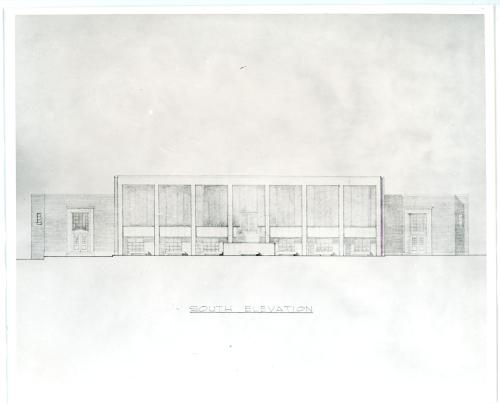
In June 1963, Director Dale Brostrom announced that the name Commons would be changed to Union as "the first step in a program . . . to make the Union the social, cultural, and recreational center of campus life." He stated that the name Union would imply "the greatest amount of usage" by students, off-campus groups, and faculty and staff. The Regents approved this name change on August 9, 1963. But that name, as applied to the old Commons, was short-lived. In January 1964, the Regents approved a request to split the proposed project into two parts: one part was the remodeling of the Union (the former Commons); the other part was the construction of a new Union. This new building would eventually become known as the Maucker Union. As of September 1, 1964, the Union (the former Commons) would revert to the former name, the Commons. The remodeling budget was $700,000, to come from student fees. Plans called for the Commons to become the dining facility for Bartlett Hall, Lawther Hall, Baker Hall (then a men's dormitory), and a proposed additional men's residence hall.
In November 1964, Dale Brostrom announced that the Fountain Room, a long-time student favorite, would be closed and moved to another part of the Commons. He also announced the shifting of the television room and some furniture. Students protested, but the changes remained. In May 1965 the Regents increased the remodeling budget to $800,000, with an additional $20,000 for a new freight elevator. Most of the proposed remodeling would involve interior work, but the south terrace would be enclosed with glass to make an entry hall, and a large stairway would be built leading to that hall.
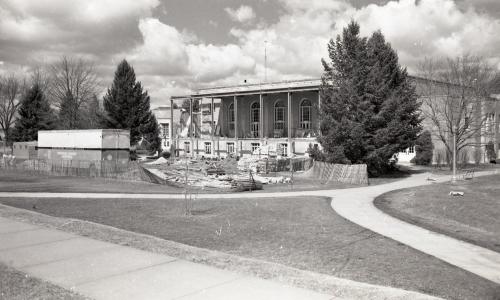
In October 1965 the Regents awarded a contract of $720,414 for the Commons remodeling. Work began in November 1965, with a completion date set for August 15, 1966. The major work would include enclosing and extending the south terrace, connecting the three dining rooms, and installing new kitchen and air conditioning equipment.
Commons closed on May 28, 1966, to allow contractors to complete their work. Some of the work trailed into the fall 1966 semester, and, with the new Union still under construction, Commons staff struggled to find recreational space for students. The biggest sore point might have been the juke box, which had been placed in storage until its new space was completed. A rainstorm early in October 1966 that left six inches of water in the Commons basement did not help matters any. Grumbling continued over things such as the Faculty Men's Lounge, a room that some students believed could be put to better use.
By late 1968 people were speculating over the future of the Commons, once the new Union opened. Many offices in the Commons would move to the Union. John Zahari, Director of Dining Services, stated that the Commons would function simply as a dining facility and lounge for residents of Bartlett, Lawther, and Baker Halls.
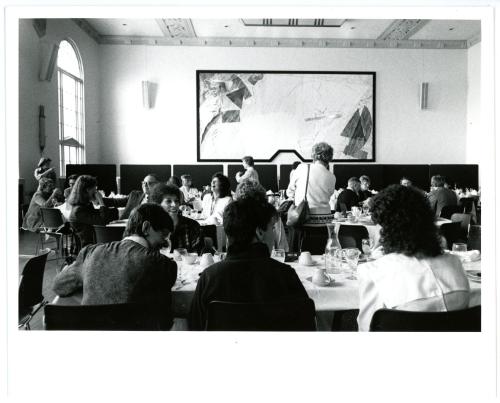
In November 1972, the Regents awarded contracts totaling $28,826 to remodel about 8360 square feet of space in the Commons for the Educational Media Center, which had lost its offices in the May 12, 1972, fire in Old Gilchrist Hall.
In 1978 the Commons cafeteria started a significant trend when it offered the first non-smoking area in a campus dining center. Director of Dining Services John Zahari was certainly correct when he predicted that this trend might soon spread to other dining centers. In 1980 the Commons was one of seven campus buildings modified to increase its energy efficiency. In 1981 the ballroom was painted and refrigeration equipment was modified. Probably related to the wishes of President Curris to improve both the quality of service and the appearance of the UNI campus, the Commons began to offer elegant meals for special occasions or visiting dignitaries.
In 1986, the Office of Alumni Relations moved into nicely remodeled quarters in the Commons. This location allowed staff more easily to accommodate requests from visiting alumni. In 1991, the Regents approved a contract of $244,640 to renovate space formerly used by the Educational Media Center into dining facilities. In 1994 work began on other former Educational Media Center space. Offices would be remodeled so that Alumni Relations and University Development could be housed together. The ballroom would be repainted, and the former terrace area would be renovated to open onto the Georgian Lounge. The project, budgeted at $975,000, brought the Commons into compliance with more stringent fire safety and handicapped accessibility standards and also restored some of the building's original Art Deco style.
The Commons is now mainly an office, lounge, and dining center.
The Commons Ballroom was dedicated in 1995 in memory of two alumni, Harry G. and Polly Prichard Slife. The building houses offices of Alumni Relations, University Development, and the UNI Foundation. The lounge and ballroom areas are used for official university dinners and receptions, conference dining, and some student activities. In addition, the 23rd Street Market, located on east side of the Commons Dining Center, serves as a campus convenience store.
The Commons Dining Center is on the university's five year list for a $3.2 million renovation. However, in February 2004 the Department of Residence announced that the dining center would close at the end of the spring 2004 semester. Against a backdrop of severe university budget cuts, officials stated that closing the dining center would save about $1 million per year. They believed that students who had used the Commons Dining Center would be accommodated in the newly-renovated Towers Dining Center. Plans are for the university catering service and 23rd Street Market to remain in operation in the Commons.
Compiled by Library Assistant Susan Witthoft; edited by a University Archivist Gerald L. Peterson, July 1996; substantially revised by Gerald L. Peterson, with research assistance by Jordan Ockerman and scanning by Gail Briddle, October 2003; last updated, January 28, 2015 (GP); Photos and captions updated by Graduate Assistant Eliza Mussmann May 10, 2022.

